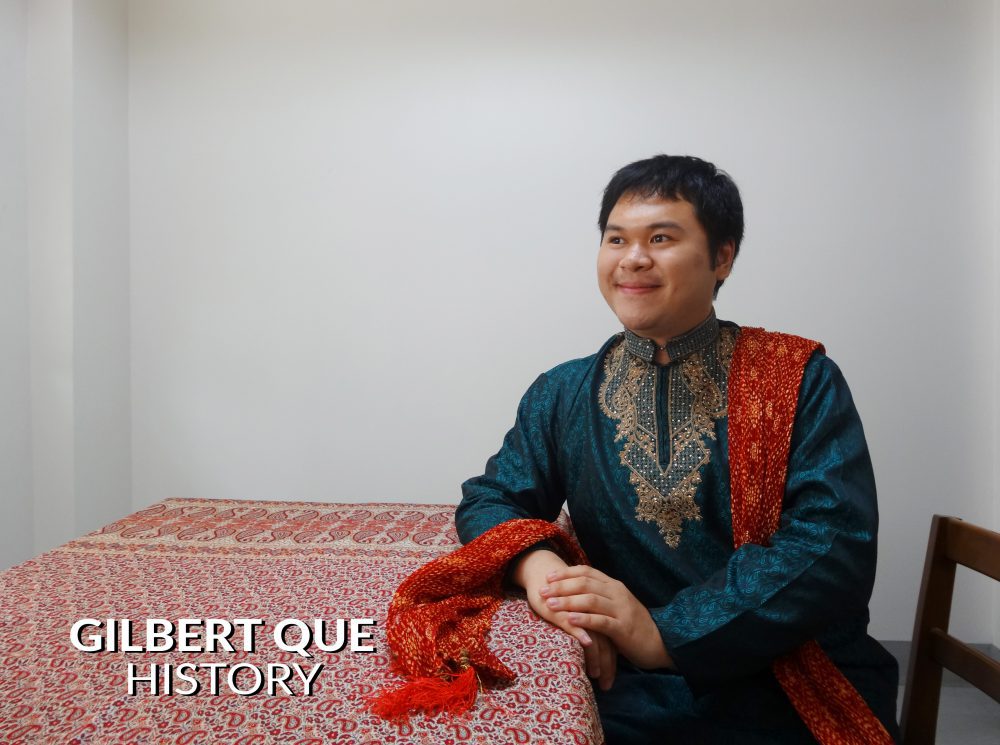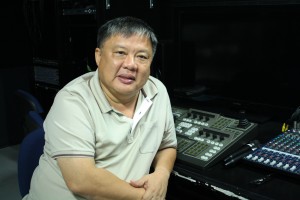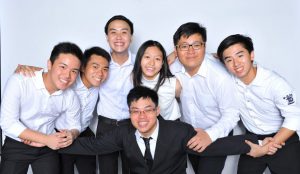For Teachers’ Appreciation Week 2016, Joel Lim and Lucas Po interviewed Mr. Gilbert Que, who teaches Communication & Asian History classes, as well as an elective on the Korean Wave. He is well known for his eccentricity in class, his colorful Asian attire reflecting each of his lessons in class, and his singing and dancing during class, with one of the highlights being a one-man show of Miss Saigon.
Joel Lim (JL): So, sir, what inspired you to become a teacher here in the Ateneo?
Gilbert Que (GQ): Teaching is innate, like, when I was young, I would…usually like to play [games where I get to] play pretend, which is also not surprising that I’m involved somehow in theater. Tapos, I also like [pretending] where I’m the teacher and I’m teaching stuff, or either I’m doing my own cooking show, which is also not surprising because I like to cook. Ayon (There.) So teaching is innate, so as young as “I don’t know”, siguro (perhaps) grade school or kinder, I knew that some point in my life, I had to teach something. I just didn’t know what I wanted to teach, but I knew that I had to teach somehow, parang ganun (something like that). As I grew older, siyempre (of course) I found out na in college, you have more liberty to teach your classes.
JL: Why did you decide to teach both History and [Communication]?
GQ: Ang uso kasi ngayon (What’s trending now), in the academe, is if you’re interdisciplinary, you’re exposed to many, many things. It’s not really just exposure, you’re trained in many things, so you’re credible in doing many things. In my case, I was a Comm major, but my graduate course, my MA course in UP Diliman was Asian Studies, specializing in Indian Studies. I have genuine interest in Asia since I was very young, which made me different, like, most of the other children are either interested in the West. Pag sa Asia naman, very, very specific na. (As for Asia, the topics tend to be very specific.) Korea then wasn’t a thing, di ba (right)? [There was no] K-pop before, so people were into anime, and to a certain extent, Taiwanese dramas, pero short-lived lang naman iyon (but Taiwanese dramas were short-lived), ‘di ba mga Meteor Garden back then. [But for me really, my interest] was really on India.
I pursued that [during] graduate school, and most of my scholarly works [in] graduate school, like term papers or conference papers were all about media and Asia. So my background and the things that I’m researching on are about [Communication] and about Asia. [For] me to do a research on Comm and Asia, I [needed] to have a deep understanding of Asia. If I were to study Asia, I need to study the other things [involving] Asia, so, like, I have a working knowledge of, [for example, the] political structures [of] Asia, the basic economic flows of Asia, although [my real] specialty is on culture and society. If you want to study area studies, meaning, [for example], European Studies, Asian Studies, [or] African Studies, you need to understand the society and culture foremost. [Communication], or at least mass media, is very related to that as well, so they go hand-in-hand in the things that I’m doing. I’m credible for both. It’s just that my scholarly background on research, on theories are very Comm so I guess that’s where they decided [that the Communication] department [would be my] home department. Although, you know, siyempre (of course) [that] I work in close ties with [the] History [department] as well.
JL: So far, what do you like most about teaching?
GQ: Oh my God, ang dami (there’s so much). Well, teaching is the best part about my job, [because] apart from teaching, we have to do other things for the department, yung mga (like) advisement or research. But for me, teaching is the best part of my job because I get to interact with other people, [because] I like talking. I like interacting with people. I like getting to know people. I like knowing their stories, although in class, most of the time, it’s me doing all the talking [because] I’m the one teaching, but I always try to get to know my students [too]. And I get to interact with students from different backgrounds, especially exchange students, because it gives me a chance to get to know other cultures and societies more. I think that’s the best part about the job: it’s the chance to interact with other people, and a chance to interact with people younger than I am so I get to know what’s uso always (always trending). So at least when I talk to young people like you, I get to know what’s uso, what’s in, I get to know the latest slang words. And I try to use them in my class, so students can get to understand the lessons more. It’s also a chance for me to perform and sing and dance. You [know] I do that in class. Ayon (There), [mainly, what I like the most about teaching is the] interaction—interaction with other people.
JL: What was the most memorable moment you’ve had in class?
GQ: Every sem, there are a lot of memorable things that happen to me. Some good, some bad. But I think the most memorable so far in my early career in teaching would be during Intersession. I was teaching HI16 as well, I have one class. You know when I discuss Southeast Asia, particularly the Vietnam War, I talk about Miss Saigon, and I do a one-man show of Miss Saigon just to enrich what the students know about the Vietnam War, or at least enrich my lesson on the Vietnam War.
So I started singing “Sun and Moon”: “You are sunlight and I, moon; joined by the gods of fortune…” And then this student, out of nowhere, bigla siyang sumabay (sang along). [Because] she knew the lyrics, [and] “Sun and Moon” is [really] a duet, so we had a duet until I think the first chorus. It was not staged.
I did not expect that, kasi, “you are sunlight and I, moon”—tapos bigla siyang sumingit (then she interjected)—“joined by the gods of fortune”. We had this dramatic pause. We just stared at each other, parang (like), “Is this really happening?” [Then], the class also thought it was staged, it was scripted, but it’s not!
The girl knew all the words. We sang together. It’s not just “Sun and Moon”. Later on we sang “Bui Doi”. It made the class a lot more fun. It was [actually] one of the items in [the] secret bucket list of my teaching career na sana (that hopefully) I get to have duet with a student. When I tell my friends about that, it’s almost too hard to believe din (for me as well), eh sa kanila na parang (and they would be like), “Are you sure na hindi talaga (that it’s not really) scripted? You did not tell your student to…” [I’d say], “No, talaga. As in, wala. (No, really. As in, really, it’s not.)” So far, I think it [was] one of the most memorable moments of my life here as a teacher.
JL: One of the memorable things that people know about you is that you dress up a lot during class. When did you start this practice? When did you decide, “Oh, I’m supposed to be dressed”? And why do you do so?
GQ: One thing you should know is that I always dress up during class. It’s not just occasionally. I always dress up for class, you know that. I always dress up like this on a daily basis as well. Like, most of my clothes are cultural in some way, yung mga “normal” clothes ko (those “normal” clothes of mine), they are a minority group in my closet.
Most of my clothes are cultural. However, I dress up depending on the occasion. Like, I have casual ones, [for example], I have Chinese collared ones that are [somewhat] casual and I can wear them every day. I have my casual hanbok, and they are really made to be worn on a daily basis, so the fabric is made of cotton; it’s not silk, it’s not shiny, it’s not glossy. I [also have] casual kurtas that I wear everyday. [The one I’m wearing for the interview right now] is a more formal one. It’s made of silk, and I think this is from North India.
Noong bata pa ako (When I was a child), I liked dressing up. Kaya nga (That’s why) I like to play pretend. I was in theater for all of my high school life. I’m helping out with my high school theater group even until now. I’m actually a moderator, not just a volunteer. I’m a moderator now; co-moderator rather [‘cause there’s two of us]. But I think I started wearing these things [starting] college? I wanted to wear [them even before], it’s just that I had no opportunity, kasi siyempre (because of course) my parents did not want to buy such things for me.
I started buying my own clothes [especially] in college [when] I had more opportunity to travel. I think I started wearing them [when I was] second year college, when I had HI16 (Asian History). Sometimes it’s hard to think of what to wear on a daily basis, [so much more] before [when] I was very “fashown”.
[Before] I was just the T-shirt and jeans type of guy, and for some people, they’ve seen me like that, but for people who have known me in the last five to eight years, they do not know me as that person anymore. [But] now I wear [cultural clothes] a lot. I would usually wear something that’s related to what we’re gonna discuss for the day, so [it was there that I realized that], “Oh, okay, apparently this works.”
[For] HI16, each lesson is about a certain culture, a certain country or a certain region, so it makes it easier for me to decide what to wear for the day. And it’s also my way of letting the students be exposed to the culture, [because] I know [that] most [of] History are [just stuck in the] books, Powerpoint slides, or handouts. [But] for me, history is a lot more alive than the text or the words in the readings [from] the books. So yun nga (So there), apart from singing, apart from dancing, I thought of wearing different things [too].
And it’s not hard for me [because] they were already a part of my collection even before I started teaching. Even when I was in UP, I would dress up the same way as I would dress for classes. That’s why, in UP, they banned me [from] all the costume competitions, [because] if I were to join daw (they said), no one else would join. Kasi parang (Because like), I’m the epitome of Asian-ness in terms of attire or something [according to them].
Dressing up like this is part of my everyday life. Even in formal events, that’s when I pull out formal, [Asian] clothes [because] I don’t like wearing the typical coat and tie unless it’s required. I don’t like wearing [them] kasi ang init, ‘di ba (‘cause it’s hot, right)? At least when I wear something Asian [and] formal, [it would hit] many birds with one stone. The attire is lighter, [and] if you’re in a coat and tie, ang daming (there’s so many) layers. At least if it’s a kurta, it’s just one layer. I just wear the kurta and it looks nice. It looks formal. People will also be curious as to whatever it is I’m wearing, [and] it’s also a chance for me to casually influence them with my “Asian-ness”. So it’s hitting many birds with one stone.
JL: Yeah, in a way, like what do you envision them as?
GQ: I think the first thing, or at least, the most important thing that I want them to learn is to be more observant of their surroundings, to be more critical, to be more understanding of their surroundings. I notice that [there are] a lot of conflicts [around,] such as casual conflicts, misunderstandings between friends, [etc.]; it’s not even cultural. It’s not academic. Parang (Like,) a lot of those things kasi (because) happen because of a lack of understanding and a lack of communication. [A] lack of understanding of the context is a lack of communication and sometimes these conflicts can grow to a global scale.
One thing that influenced me to be very cultural, or one thing that added to why I was cultural [was firstly] my parents, [another thing which made me] more passionate about it were the 9/11 attacks. I was in grade school then, so all the news channels were talking about 9/11 and they were blaming the Muslims, di ba (right)? Well, I understand that those that were involved in it were Muslim extremists, meaning they’re a “special” group. Let’s just put it that way. They’re extremists, but because of that, people started misunderstanding the Muslims. They said na (that) all Muslims are terrorists, all Muslims are bad, and it’s not just Muslims, eh. Those people na (that) they think look Arab[ic] [like] Indians [were] lumped together, and people [that time] were starting to say that the Muslims were bad. So, it made me think, you know, parang, weird enough nga eh . Sometimes I look back, and I think, “Wow, grade school ako and naisip ko na pala yung mga things na iyon.” Kasi siyempre, (Of course,) grade school people usually laro or something, pero siguro that time, I don’t know what made me think that way, but yun nga (yeah) I thought na… kasi (that..because) in school we were taught na (that) the Muslims were peace-loving people. Siyempre, (Of course) basic Social Studies pa iyon noong grade school, so parang, sabi ko (like, I said) if they are peace-loving, why are they doing these things? Let’s say na Muslims sila, but terrorists sila, but kung baga they are terrorists who just happen to be Muslims. Di ba? Minsan naisip ko iyon (Right? Sometimes, I’d think of it). I know a lot of Muslims who are not like that, who are not terrorists. So, parang, it got me thinking, tapos nadadamay sila kasi (and then they’re affected since)…people generalize [that] all the Muslims are terrorists, even until today.
Or kunyare, even the Indians; people give them different names [which] I felt [that] it’s unfair to them [because] since I was young, I’ve been watching Indian movies, watching Indian series, even though I didn’t understand a [single] word. I said to myself that the Indians are not like that, the Indians have a nice culture. Even though I did not know a lot about India, I was fascinated by it. It’s just that I did not have a lot books about India at home, that is why I don’t know that much about India, apart from itis a big country, and that Indian people look different from Filipinos or Chinese [because] they wear the sari.
[That is why when] I talk to people, or when I eventually teach, I wanted my students to be understanding, to be critical of their surroundings. You don’t need to be an Asian expert or a culture expert to get to know people. If you don’t know anything, or if you only know a little about a specific society or a specific culture, you ask, you talk to them, you know their stories. And in that way, you will understand them, and you will know if…how they are represented in influential texts like textbooks, mga history books, TV, films, or social media.
JL: Understanding?
GQ: …understanding, or you will begin to see or analyze if tama ba ang way that they are represented. Although, siyempre, each kind of representation is subjective naman talaga. But at least you have a better understanding na they are more than [their stereotype]. You get to become more open. You get to learn to respect other people more. You learn not to laugh at them. It’s also another reason why I wear these things. Apart from that, I like the style, but it’s also a way for me to…
JL: Empathize?
GQ: I don’t want to use the word “empathize.” It’s just a way for me to respect and to teach other people about other cultures.
JL: So it’s a way to honor their cultures?
GQ: Yeah,[because] when I started wearing these things, my parents were a bit worried [that] people might say that I’m crazy, or people might say na I’m “disrespecting” the culture. I know my parents were just watching out for me [but] in my case, that was my way of letting other people be exposed. So my friends before who had really skewed ideas about the Indians, now they are very open, and when I started wearing the kurta, they started asking me about the kurta. At least now, when they watch Bollywood films, or when they go somewhere in another country, and when they see an Indian, they do not [think about the stereotypes] anymore. They say, “They’re Indians.” They’re Indians; they have a nice culture; they wear kurtas. They even know what they’re called na – they are “kurtas” [while] the girls are wearing saris or salwar kameezes [which are] nice. They’re interesting. There’s something that’s to be learned about them, or to be understood about them. So, at least that’s the little way na I think I’m influencing other people to become more open to what it is that we have in this world.
JL: And to add to that, I think you’ve immersed yourself in exploring culture through travelling to different countries around the world. So, you’ve shared your travel experiences around the world during class, so do you have a lot of time in travelling?
GQ: Oh, I used to, but when I started teaching, not anymore. I just take advantage of the breaks that we have, or sometimes I travel [because] I have conferences. Most of my travels recently are for official purposes, either to present a paper in a conference, or to represent the Philippines for whatever delegation, so, like, I’ve represented the Philippines as youth delegate in India, in Korea, in Mongolia. Tapos (And then,) I’ve presented papers in a couple of countries in Asia, and last year, I presented in the U.S. [in] an Asian Studies conference. Leisure travel, it doesn’t come as often anymore, so I just take advantage of the breaks [like] Holy Week, or yung mga (those) in-between the second sem and intersession. Or between intersession and first, or Christmas Break. But I try to take advantage of the little time that I have in whichever foreign country I go to. Iyon, para hindi naman sayang yung punta ko (laughs) (There, so that I won’t waste my effort in travelling there.)
JL: …where do you travel to usually?
GQ: I don’t have a favorite country [to travel to because] each country has its pros and cons. Although some countries might be a bit more comfortable to travel around [in], or the people of this country might have more hospitable people, but I think this is one expected answer of me [that] my “favorite” country to go to would be India.
Yes, I know [that] we’ve heard a lot of bad things about India because of mass media, but unless you go to India, you don’t really know what’s up. Yes, those things do happen. Bad things happen in India, but bad things do happen all across the globe, and anywhere in the world. So [maybe] things that were happening in India [were sensationalized] which made a lot of people scared to travel to India. And while those bad things may happen, India is really a fascinating place to go to, like, even the first time – I’ve been to India twice – so the first time I went to India, I felt na every corner had something interesting, had something picture-worthy, ganun. Kasi I like taking pictures. I’m not a photographer, but I like taking pictures, like, for documentation lang of my trip.Yung [The] typical tourist thing to do.
JL: And with your profession comes a lot of frustration, just like, you know, it gets kinda busy, especially you’re also balancing your life as a theater actor also…
GQ: I’m not a theater actor. I’m not a professional theater actor; I do mentoring. I teach high school theater people.
JL: So in spite of all these, what drives you to keep teaching?
GQ: Well, one, it’s innate. So, if I don’t do it, I die. It’s part of my system. So if I don’t do it, I don’t think I’ll find some kind of fulfillment, [because] I feel na it’s already, like, a long-time vocation. It was one of the many vocations I have in my life. That’s one.
Two, it’s to get to interact with the students. I like interacting with my students. I like to see what they are up to. I like to see how I can help them, although I’m not saying that I want to change them or what, I respect them as people with individual preferences, or with personal likes and dislikes, but I also wanna see different parts of the society. Like even Ateneans students are quite diverse.
JL: For all of your former and current students, if there is one advice you would give to them, what will it be?
GQ: My advice for them is to be more observant of their surroundings, to learn more about their surroundings, to respect everyone around them [which] comes with understanding them, and to do good. Very fundamental things, but I think that a lot of people forget about them. So those are the very basic things that I want them to learn in life for any students, even for my theater students [in] Chiang Kai [Shek College], that’s the same thing of what I want them to do.
JL: To flip it around naman (this time), what is the most important thing you’ve learned from your students?
GQ: Well, the most important thing that I’ve learned from my students is [a lot depending on the students]. But [maybe], what I learned from my students is that [I am being challenged every time I teach] that’s why I learn. Kasi (Because) my students “teach me,” or show me that times change a lot. That times change quickly. The way we learn before noong college pa ako (The way we learned when I was still in college before), is different than how students learn things in today’s world, [that is why] I need to keep updating the way that I teach, or the way that I communicate with my students so that they will understand the lesson. So, at least in my career, [that’s] the thing that I was challenged by students, and I ended up learning, [because] sometimes I ask students, [especially those] would have difficulty in understanding the lesson. I ask them, “Why do you have a difficult time understanding it?” [Also], I have students who [had to retake HI16 because] they did not do well in their previous class, so I ask them, “What happened in your last histo, [maybe] I can do something about it,” [because] I don’t want you to retake histo again in the future. That is [maybe why I am challenged by my students]. They show me that times are changing, and as a teacher, I need to…compromise…or try to adapt in some ways, so students can learn, and the same time, I send my message across-the lesson, the ideas. I guess that’s the important thing that I’ve learned or realized from my students.
Follow the Teachers’ Appreciation Week page, to know more about professors in Ateneo de Manila!
Check out these professors in Teachers’ Appreciation Week:




